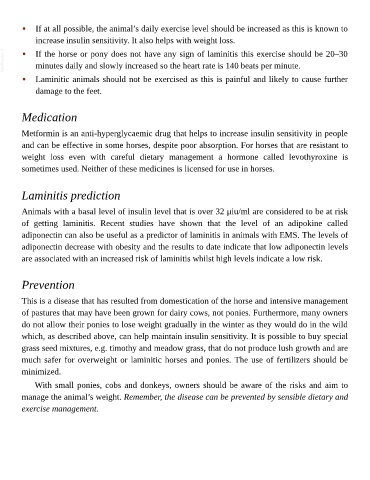Page 975 - The Veterinary Care of the Horse
P. 975
• If at all possible, the animal’s daily exercise level should be increased as this is known to
increase insulin sensitivity. It also helps with weight loss.
VetBooks.ir • If the horse or pony does not have any sign of laminitis this exercise should be 20–30
minutes daily and slowly increased so the heart rate is 140 beats per minute.
• Laminitic animals should not be exercised as this is painful and likely to cause further
damage to the feet.
Medication
Metformin is an anti-hyperglycaemic drug that helps to increase insulin sensitivity in people
and can be effective in some horses, despite poor absorption. For horses that are resistant to
weight loss even with careful dietary management a hormone called levothyroxine is
sometimes used. Neither of these medicines is licensed for use in horses.
Laminitis prediction
Animals with a basal level of insulin level that is over 32 μiu/ml are considered to be at risk
of getting laminitis. Recent studies have shown that the level of an adipokine called
adiponectin can also be useful as a predictor of laminitis in animals with EMS. The levels of
adiponectin decrease with obesity and the results to date indicate that low adiponectin levels
are associated with an increased risk of laminitis whilst high levels indicate a low risk.
Prevention
This is a disease that has resulted from domestication of the horse and intensive management
of pastures that may have been grown for dairy cows, not ponies. Furthermore, many owners
do not allow their ponies to lose weight gradually in the winter as they would do in the wild
which, as described above, can help maintain insulin sensitivity. It is possible to buy special
grass seed mixtures, e.g. timothy and meadow grass, that do not produce lush growth and are
much safer for overweight or laminitic horses and ponies. The use of fertilizers should be
minimized.
With small ponies, cobs and donkeys, owners should be aware of the risks and aim to
manage the animal’s weight. Remember, the disease can be prevented by sensible dietary and
exercise management.

